Government & NPO Accounting: Case Studies and Analysis
VerifiedAdded on 2021/04/24
|12
|1782
|38
Homework Assignment
AI Summary
This assignment provides a comprehensive analysis of government and not-for-profit (NPO) accounting, focusing on fund accounting principles and their application through three case studies. The first case examines the suitability of fund accounting for NPOs, the different types of funds used, and the specific scenarios where they are most appropriate. The second case study delves into the implications of government entities selling assets to themselves to generate revenue. The final case explores the accounting treatment of non-expendable fiduciary funds, particularly the use of the full accrual basis. The assignment includes journal entries and detailed explanations of the accounting logic and standards applied, along with an executive summary and a conclusion that summarizes the key findings and implications of the analysis. References to relevant literature are included to support the analysis.

Paraphrase This Document
Need a fresh take? Get an instant paraphrase of this document with our AI Paraphraser
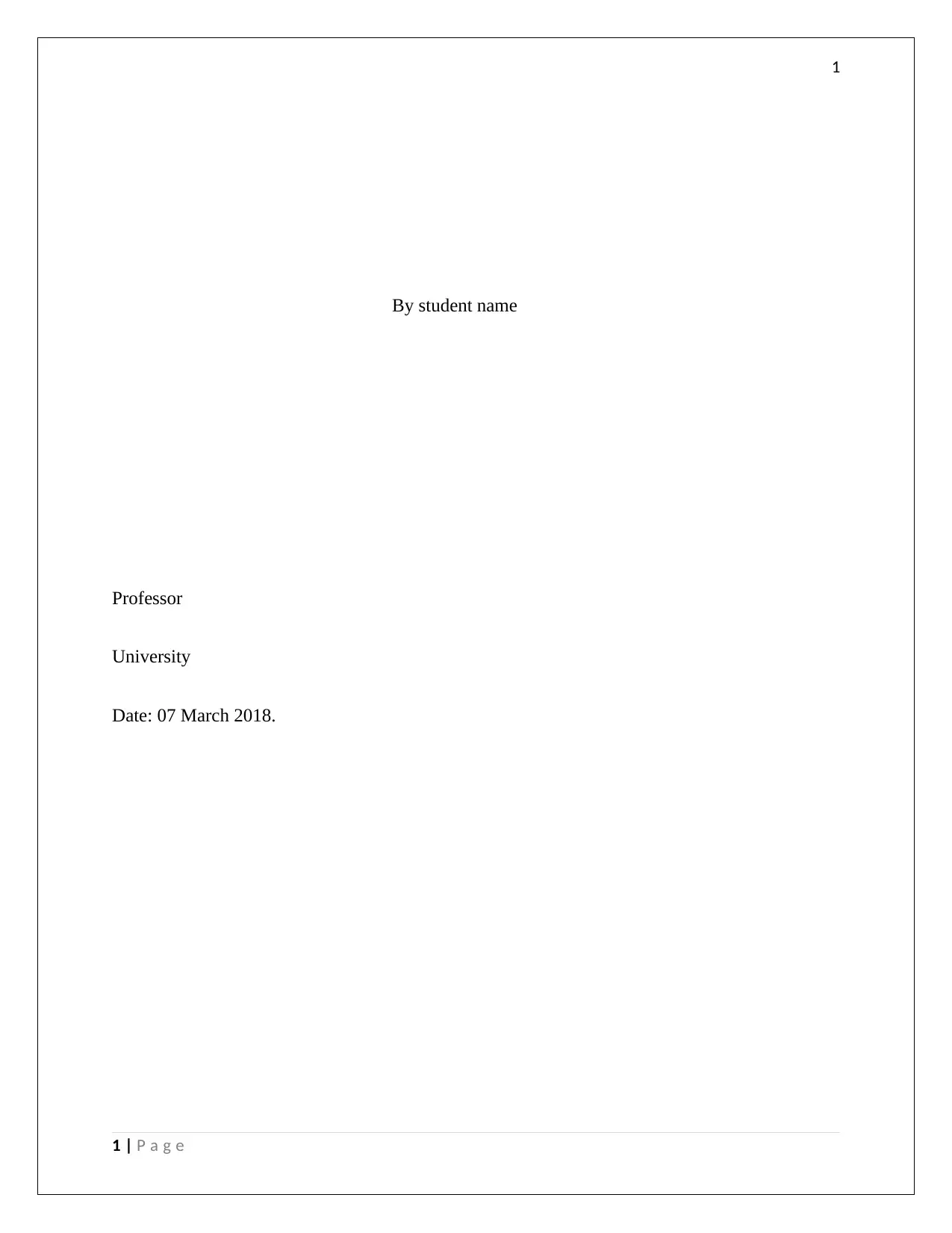
1
By student name
Professor
University
Date: 07 March 2018.
1 | P a g e
By student name
Professor
University
Date: 07 March 2018.
1 | P a g e
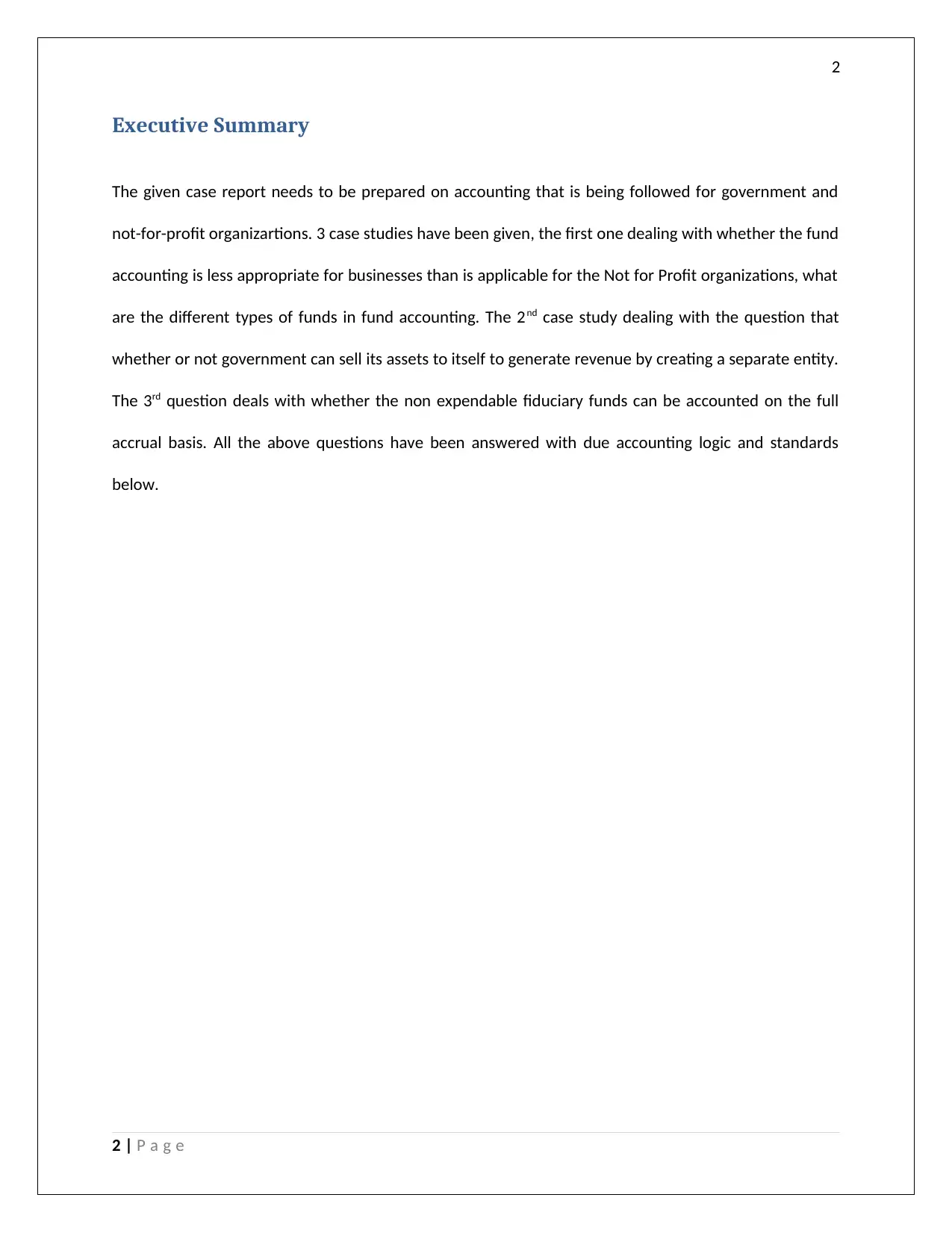
2
Executive Summary
The given case report needs to be prepared on accounting that is being followed for government and
not-for-profit organizartions. 3 case studies have been given, the first one dealing with whether the fund
accounting is less appropriate for businesses than is applicable for the Not for Profit organizations, what
are the different types of funds in fund accounting. The 2nd case study dealing with the question that
whether or not government can sell its assets to itself to generate revenue by creating a separate entity.
The 3rd question deals with whether the non expendable fiduciary funds can be accounted on the full
accrual basis. All the above questions have been answered with due accounting logic and standards
below.
2 | P a g e
Executive Summary
The given case report needs to be prepared on accounting that is being followed for government and
not-for-profit organizartions. 3 case studies have been given, the first one dealing with whether the fund
accounting is less appropriate for businesses than is applicable for the Not for Profit organizations, what
are the different types of funds in fund accounting. The 2nd case study dealing with the question that
whether or not government can sell its assets to itself to generate revenue by creating a separate entity.
The 3rd question deals with whether the non expendable fiduciary funds can be accounted on the full
accrual basis. All the above questions have been answered with due accounting logic and standards
below.
2 | P a g e
⊘ This is a preview!⊘
Do you want full access?
Subscribe today to unlock all pages.

Trusted by 1+ million students worldwide
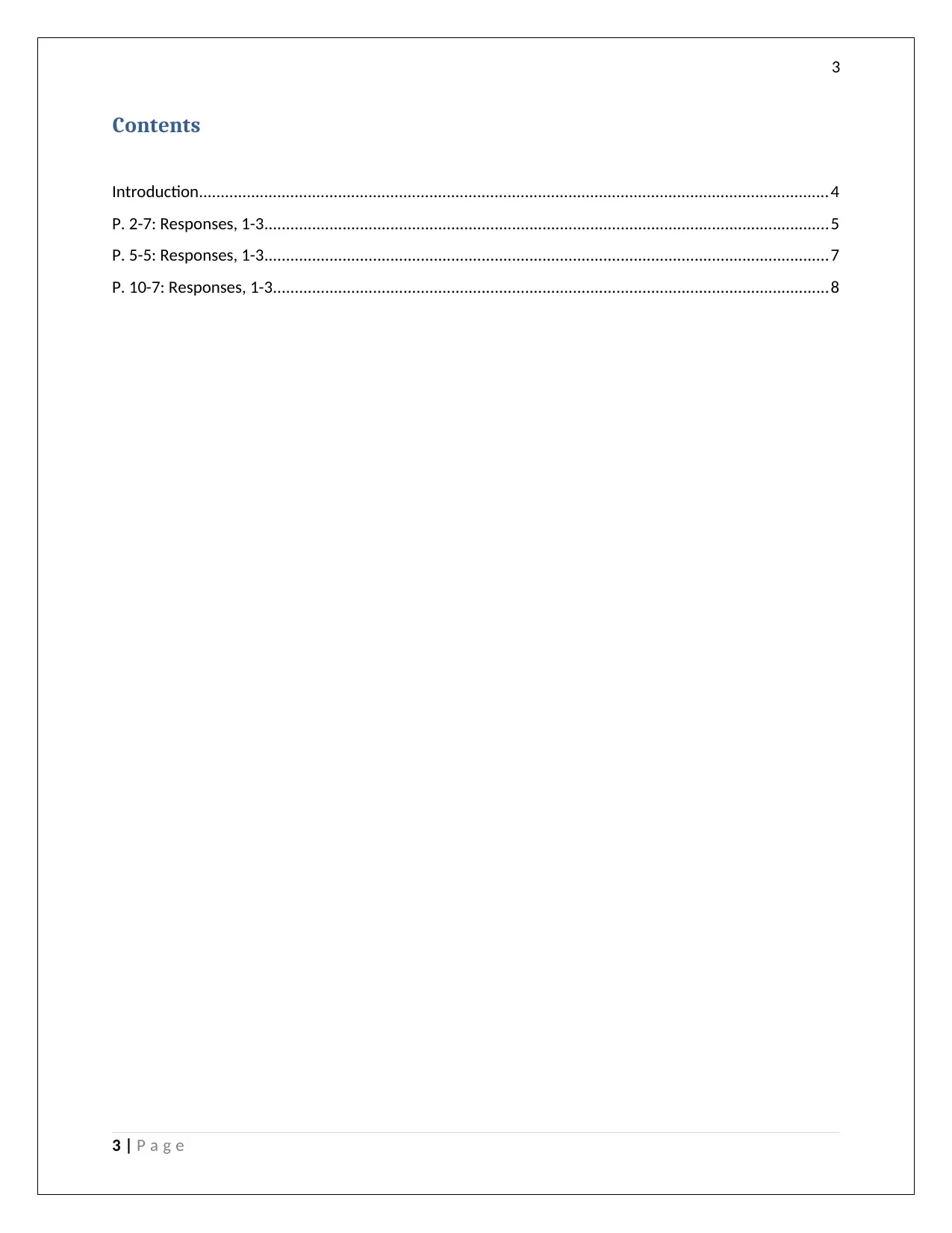
3
Contents
Introduction.................................................................................................................................................4
P. 2-7: Responses, 1-3..................................................................................................................................5
P. 5-5: Responses, 1-3..................................................................................................................................7
P. 10-7: Responses, 1-3................................................................................................................................8
3 | P a g e
Contents
Introduction.................................................................................................................................................4
P. 2-7: Responses, 1-3..................................................................................................................................5
P. 5-5: Responses, 1-3..................................................................................................................................7
P. 10-7: Responses, 1-3................................................................................................................................8
3 | P a g e
Paraphrase This Document
Need a fresh take? Get an instant paraphrase of this document with our AI Paraphraser
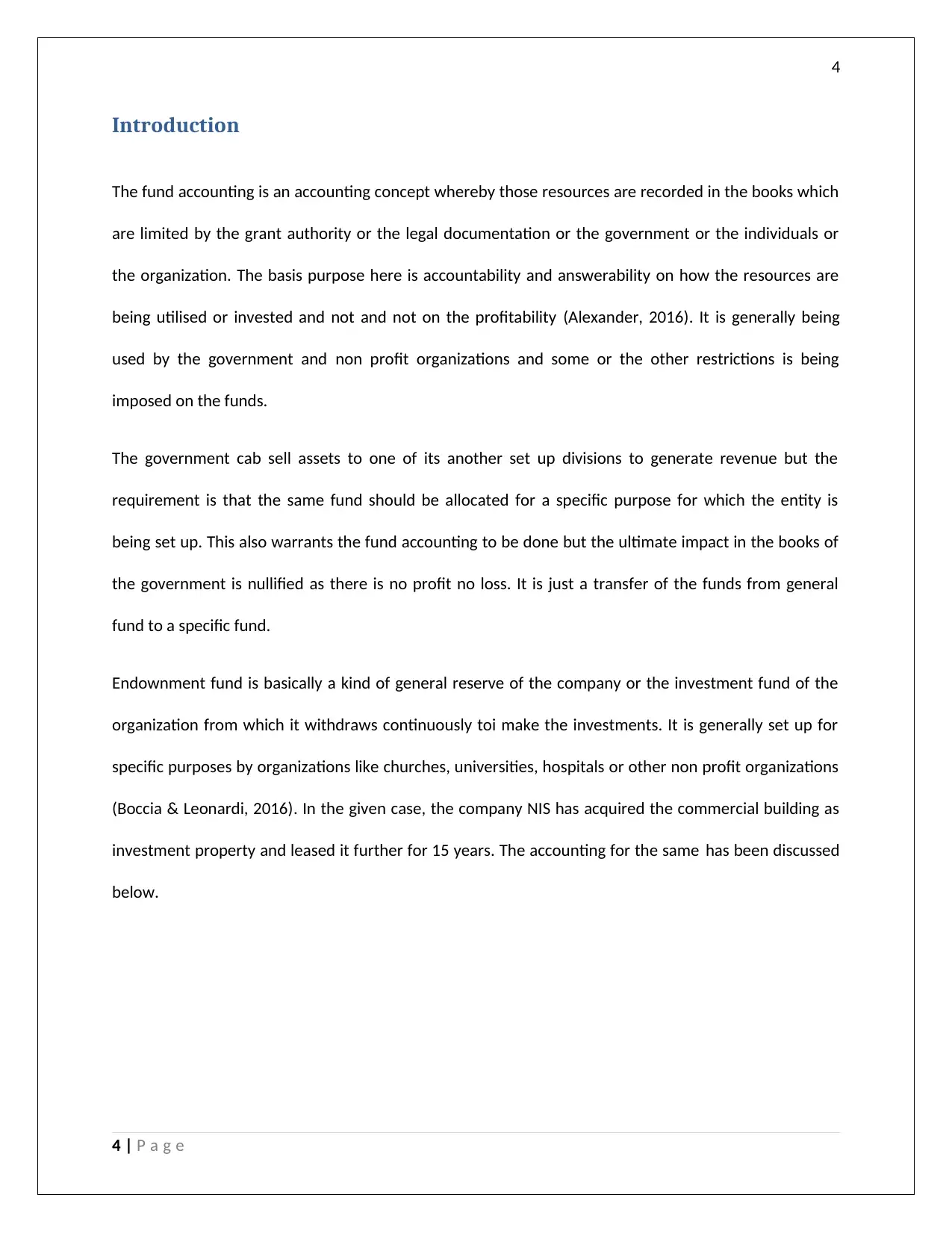
4
Introduction
The fund accounting is an accounting concept whereby those resources are recorded in the books which
are limited by the grant authority or the legal documentation or the government or the individuals or
the organization. The basis purpose here is accountability and answerability on how the resources are
being utilised or invested and not and not on the profitability (Alexander, 2016). It is generally being
used by the government and non profit organizations and some or the other restrictions is being
imposed on the funds.
The government cab sell assets to one of its another set up divisions to generate revenue but the
requirement is that the same fund should be allocated for a specific purpose for which the entity is
being set up. This also warrants the fund accounting to be done but the ultimate impact in the books of
the government is nullified as there is no profit no loss. It is just a transfer of the funds from general
fund to a specific fund.
Endownment fund is basically a kind of general reserve of the company or the investment fund of the
organization from which it withdraws continuously toi make the investments. It is generally set up for
specific purposes by organizations like churches, universities, hospitals or other non profit organizations
(Boccia & Leonardi, 2016). In the given case, the company NIS has acquired the commercial building as
investment property and leased it further for 15 years. The accounting for the same has been discussed
below.
4 | P a g e
Introduction
The fund accounting is an accounting concept whereby those resources are recorded in the books which
are limited by the grant authority or the legal documentation or the government or the individuals or
the organization. The basis purpose here is accountability and answerability on how the resources are
being utilised or invested and not and not on the profitability (Alexander, 2016). It is generally being
used by the government and non profit organizations and some or the other restrictions is being
imposed on the funds.
The government cab sell assets to one of its another set up divisions to generate revenue but the
requirement is that the same fund should be allocated for a specific purpose for which the entity is
being set up. This also warrants the fund accounting to be done but the ultimate impact in the books of
the government is nullified as there is no profit no loss. It is just a transfer of the funds from general
fund to a specific fund.
Endownment fund is basically a kind of general reserve of the company or the investment fund of the
organization from which it withdraws continuously toi make the investments. It is generally set up for
specific purposes by organizations like churches, universities, hospitals or other non profit organizations
(Boccia & Leonardi, 2016). In the given case, the company NIS has acquired the commercial building as
investment property and leased it further for 15 years. The accounting for the same has been discussed
below.
4 | P a g e
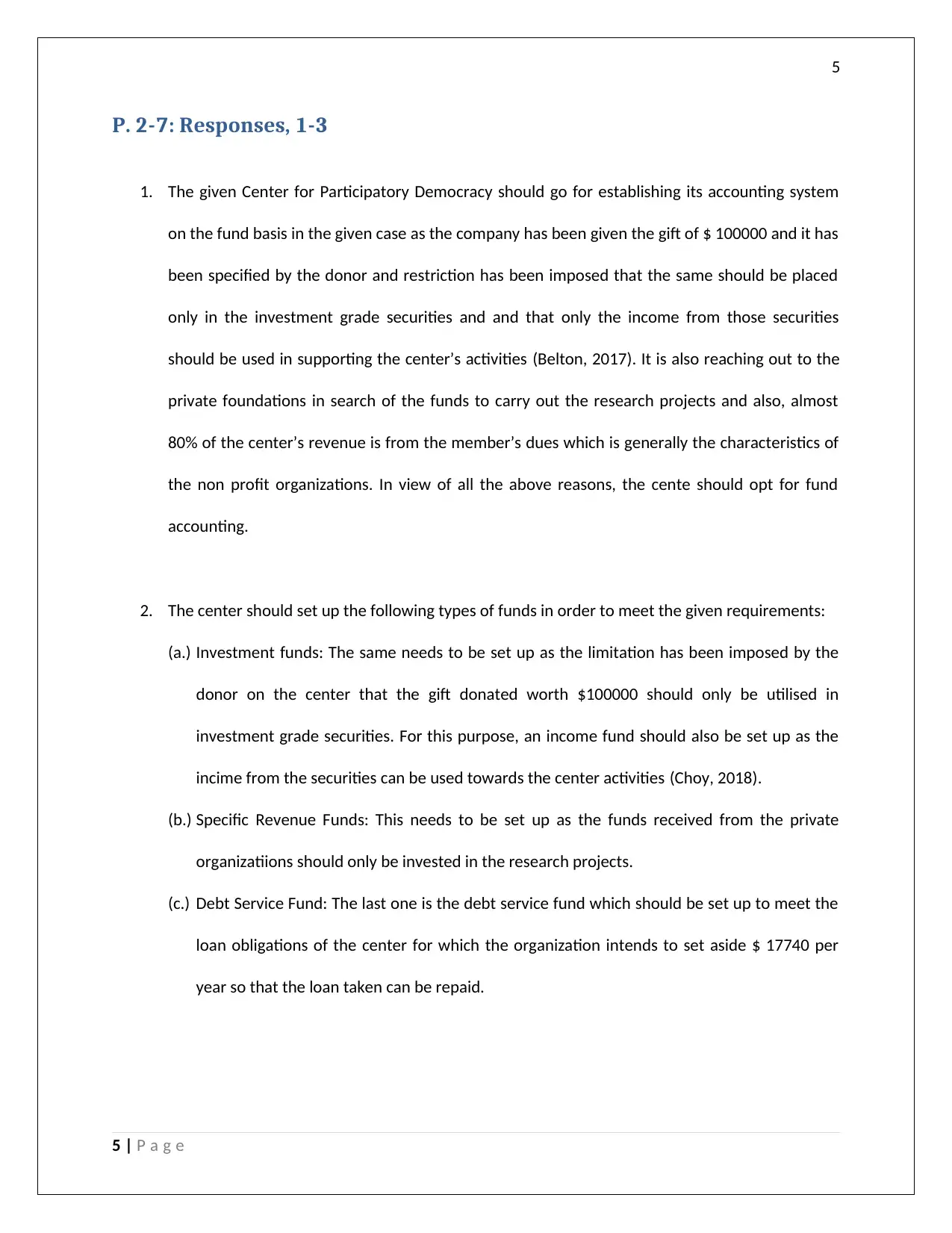
5
P. 2-7: Responses, 1-3
1. The given Center for Participatory Democracy should go for establishing its accounting system
on the fund basis in the given case as the company has been given the gift of $ 100000 and it has
been specified by the donor and restriction has been imposed that the same should be placed
only in the investment grade securities and and that only the income from those securities
should be used in supporting the center’s activities (Belton, 2017). It is also reaching out to the
private foundations in search of the funds to carry out the research projects and also, almost
80% of the center’s revenue is from the member’s dues which is generally the characteristics of
the non profit organizations. In view of all the above reasons, the cente should opt for fund
accounting.
2. The center should set up the following types of funds in order to meet the given requirements:
(a.) Investment funds: The same needs to be set up as the limitation has been imposed by the
donor on the center that the gift donated worth $100000 should only be utilised in
investment grade securities. For this purpose, an income fund should also be set up as the
incime from the securities can be used towards the center activities (Choy, 2018).
(b.) Specific Revenue Funds: This needs to be set up as the funds received from the private
organizatiions should only be invested in the research projects.
(c.) Debt Service Fund: The last one is the debt service fund which should be set up to meet the
loan obligations of the center for which the organization intends to set aside $ 17740 per
year so that the loan taken can be repaid.
5 | P a g e
P. 2-7: Responses, 1-3
1. The given Center for Participatory Democracy should go for establishing its accounting system
on the fund basis in the given case as the company has been given the gift of $ 100000 and it has
been specified by the donor and restriction has been imposed that the same should be placed
only in the investment grade securities and and that only the income from those securities
should be used in supporting the center’s activities (Belton, 2017). It is also reaching out to the
private foundations in search of the funds to carry out the research projects and also, almost
80% of the center’s revenue is from the member’s dues which is generally the characteristics of
the non profit organizations. In view of all the above reasons, the cente should opt for fund
accounting.
2. The center should set up the following types of funds in order to meet the given requirements:
(a.) Investment funds: The same needs to be set up as the limitation has been imposed by the
donor on the center that the gift donated worth $100000 should only be utilised in
investment grade securities. For this purpose, an income fund should also be set up as the
incime from the securities can be used towards the center activities (Choy, 2018).
(b.) Specific Revenue Funds: This needs to be set up as the funds received from the private
organizatiions should only be invested in the research projects.
(c.) Debt Service Fund: The last one is the debt service fund which should be set up to meet the
loan obligations of the center for which the organization intends to set aside $ 17740 per
year so that the loan taken can be repaid.
5 | P a g e
⊘ This is a preview!⊘
Do you want full access?
Subscribe today to unlock all pages.

Trusted by 1+ million students worldwide
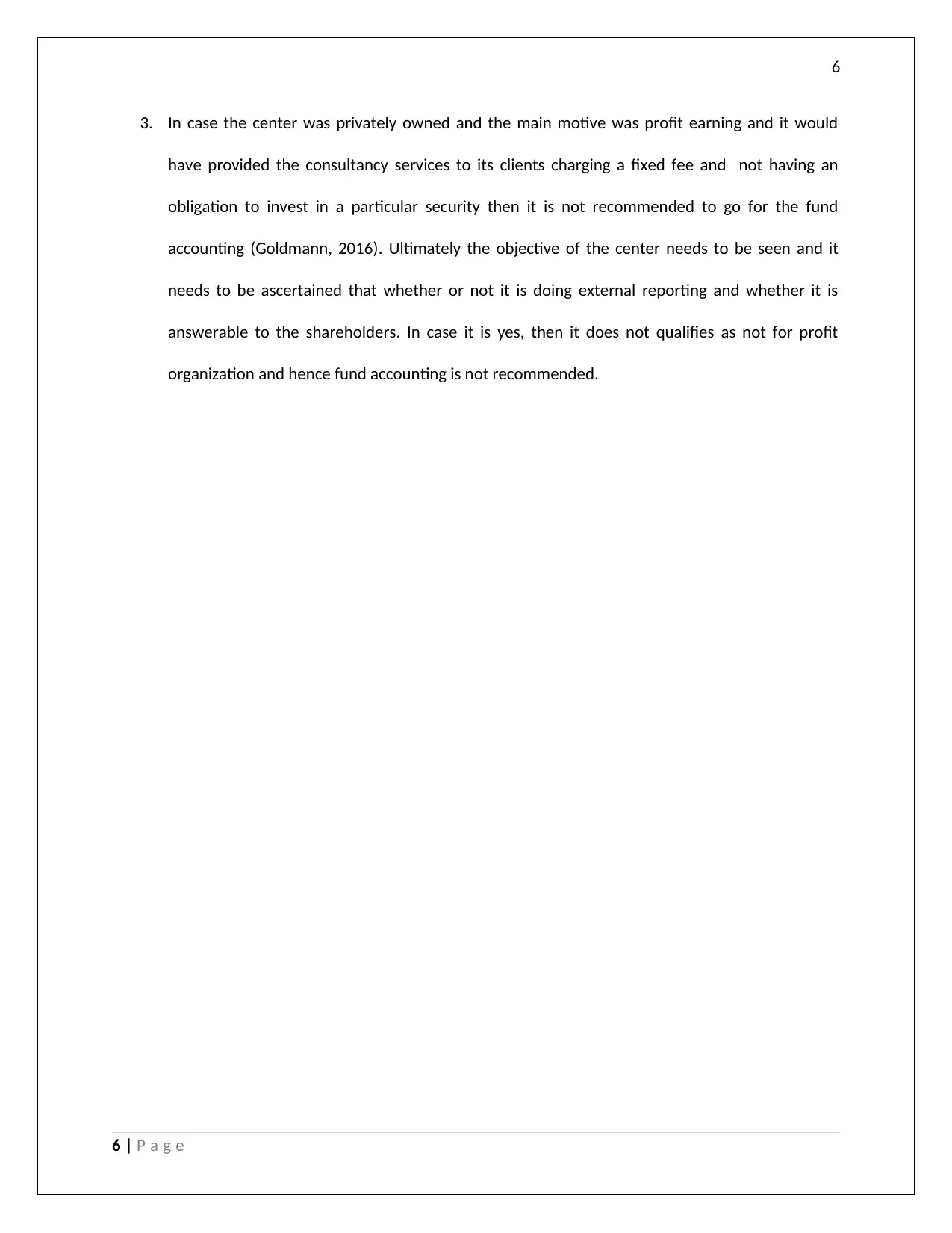
6
3. In case the center was privately owned and the main motive was profit earning and it would
have provided the consultancy services to its clients charging a fixed fee and not having an
obligation to invest in a particular security then it is not recommended to go for the fund
accounting (Goldmann, 2016). Ultimately the objective of the center needs to be seen and it
needs to be ascertained that whether or not it is doing external reporting and whether it is
answerable to the shareholders. In case it is yes, then it does not qualifies as not for profit
organization and hence fund accounting is not recommended.
6 | P a g e
3. In case the center was privately owned and the main motive was profit earning and it would
have provided the consultancy services to its clients charging a fixed fee and not having an
obligation to invest in a particular security then it is not recommended to go for the fund
accounting (Goldmann, 2016). Ultimately the objective of the center needs to be seen and it
needs to be ascertained that whether or not it is doing external reporting and whether it is
answerable to the shareholders. In case it is yes, then it does not qualifies as not for profit
organization and hence fund accounting is not recommended.
6 | P a g e
Paraphrase This Document
Need a fresh take? Get an instant paraphrase of this document with our AI Paraphraser
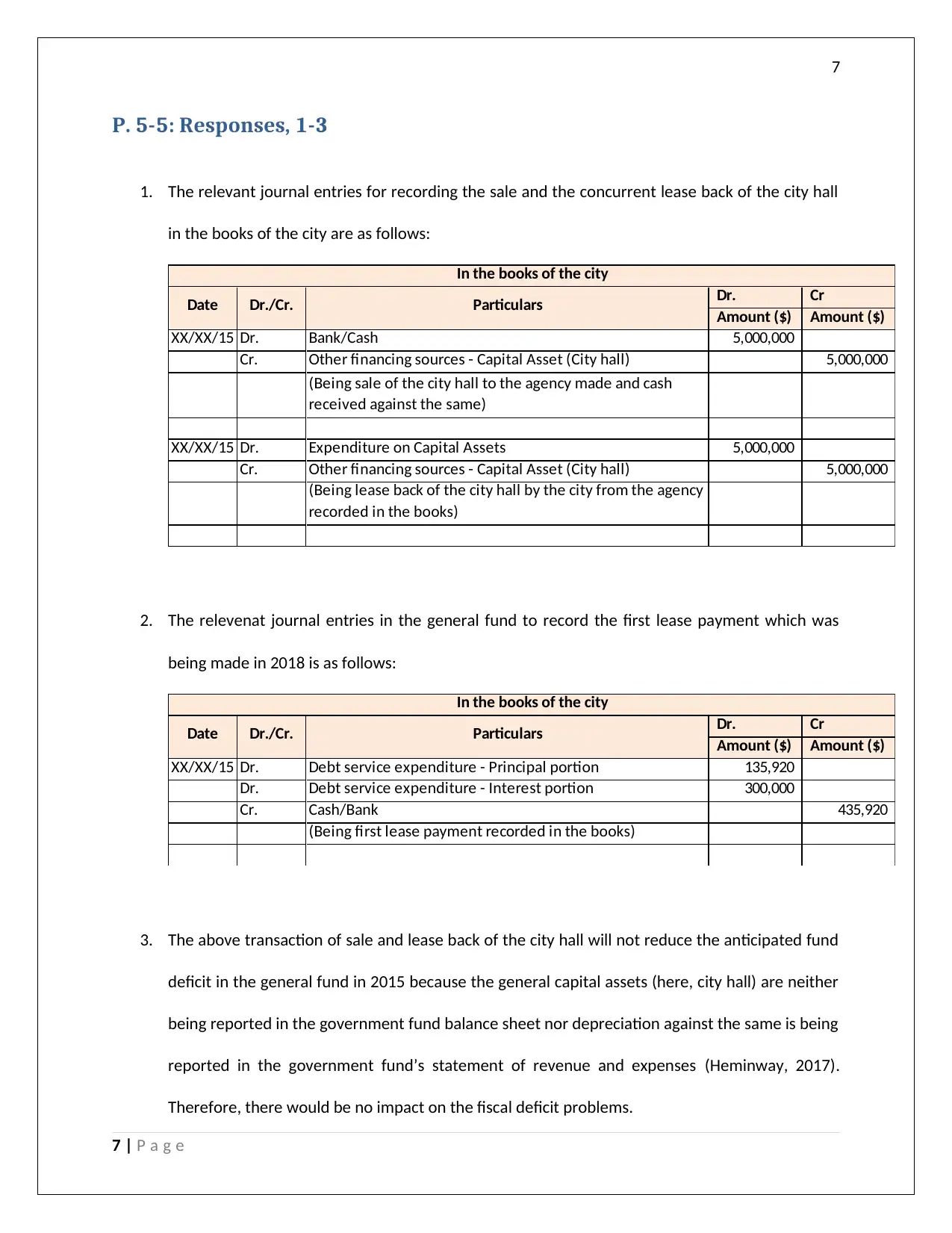
7
P. 5-5: Responses, 1-3
1. The relevant journal entries for recording the sale and the concurrent lease back of the city hall
in the books of the city are as follows:
Dr. Cr
Amount ($) Amount ($)
XX/XX/15 Dr. Bank/Cash 5,000,000
Cr. Other financing sources - Capital Asset (City hall) 5,000,000
(Being sale of the city hall to the agency made and cash
received against the same)
XX/XX/15 Dr. Expenditure on Capital Assets 5,000,000
Cr. Other financing sources - Capital Asset (City hall) 5,000,000
(Being lease back of the city hall by the city from the agency
recorded in the books)
In the books of the city
Date Dr./Cr. Particulars
2. The relevenat journal entries in the general fund to record the first lease payment which was
being made in 2018 is as follows:
Dr. Cr
Amount ($) Amount ($)
XX/XX/15 Dr. Debt service expenditure - Principal portion 135,920
Dr. Debt service expenditure - Interest portion 300,000
Cr. Cash/Bank 435,920
(Being first lease payment recorded in the books)
In the books of the city
Date Dr./Cr. Particulars
3. The above transaction of sale and lease back of the city hall will not reduce the anticipated fund
deficit in the general fund in 2015 because the general capital assets (here, city hall) are neither
being reported in the government fund balance sheet nor depreciation against the same is being
reported in the government fund’s statement of revenue and expenses (Heminway, 2017).
Therefore, there would be no impact on the fiscal deficit problems.
7 | P a g e
P. 5-5: Responses, 1-3
1. The relevant journal entries for recording the sale and the concurrent lease back of the city hall
in the books of the city are as follows:
Dr. Cr
Amount ($) Amount ($)
XX/XX/15 Dr. Bank/Cash 5,000,000
Cr. Other financing sources - Capital Asset (City hall) 5,000,000
(Being sale of the city hall to the agency made and cash
received against the same)
XX/XX/15 Dr. Expenditure on Capital Assets 5,000,000
Cr. Other financing sources - Capital Asset (City hall) 5,000,000
(Being lease back of the city hall by the city from the agency
recorded in the books)
In the books of the city
Date Dr./Cr. Particulars
2. The relevenat journal entries in the general fund to record the first lease payment which was
being made in 2018 is as follows:
Dr. Cr
Amount ($) Amount ($)
XX/XX/15 Dr. Debt service expenditure - Principal portion 135,920
Dr. Debt service expenditure - Interest portion 300,000
Cr. Cash/Bank 435,920
(Being first lease payment recorded in the books)
In the books of the city
Date Dr./Cr. Particulars
3. The above transaction of sale and lease back of the city hall will not reduce the anticipated fund
deficit in the general fund in 2015 because the general capital assets (here, city hall) are neither
being reported in the government fund balance sheet nor depreciation against the same is being
reported in the government fund’s statement of revenue and expenses (Heminway, 2017).
Therefore, there would be no impact on the fiscal deficit problems.
7 | P a g e
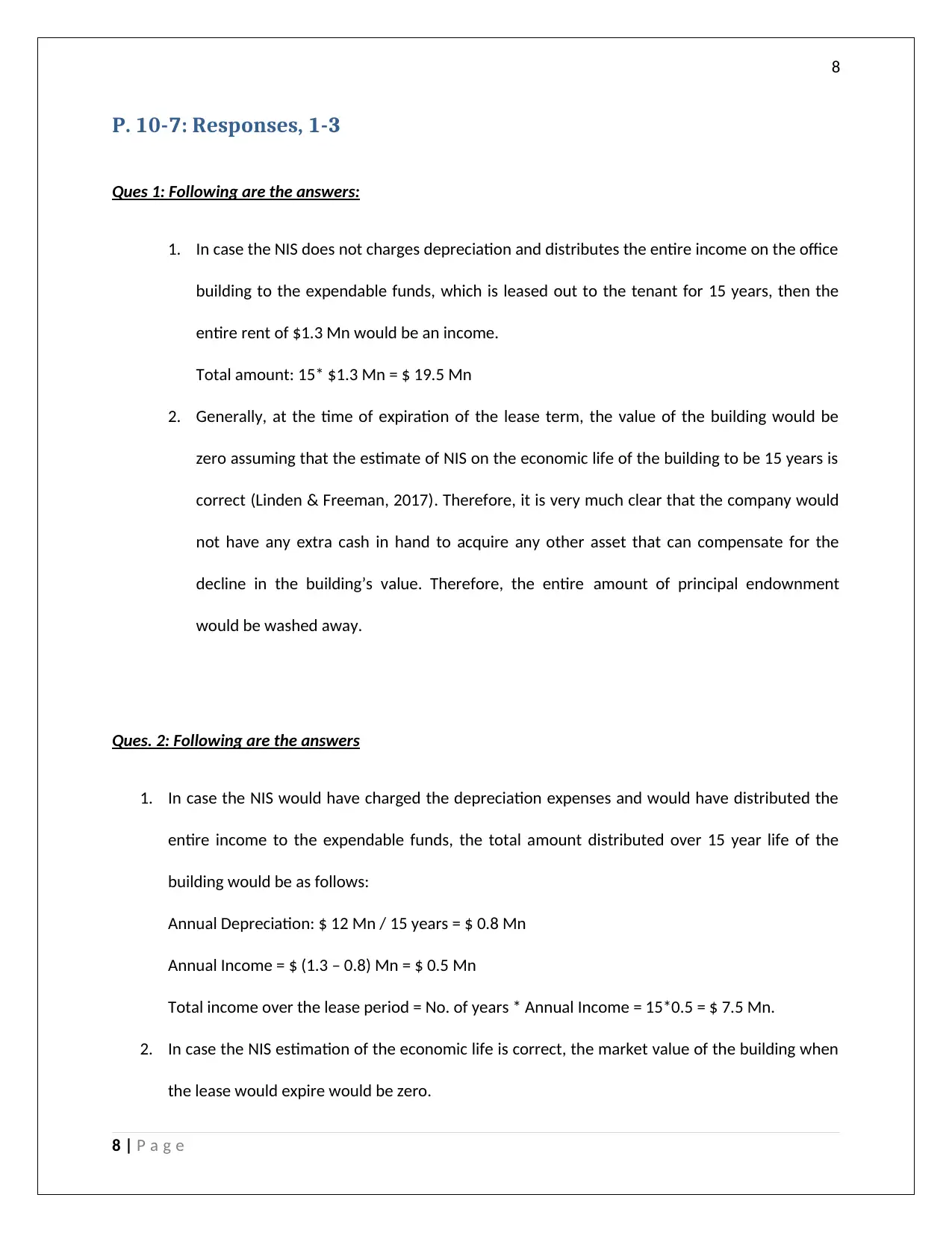
8
P. 10-7: Responses, 1-3
Ques 1: Following are the answers:
1. In case the NIS does not charges depreciation and distributes the entire income on the office
building to the expendable funds, which is leased out to the tenant for 15 years, then the
entire rent of $1.3 Mn would be an income.
Total amount: 15* $1.3 Mn = $ 19.5 Mn
2. Generally, at the time of expiration of the lease term, the value of the building would be
zero assuming that the estimate of NIS on the economic life of the building to be 15 years is
correct (Linden & Freeman, 2017). Therefore, it is very much clear that the company would
not have any extra cash in hand to acquire any other asset that can compensate for the
decline in the building’s value. Therefore, the entire amount of principal endownment
would be washed away.
Ques. 2: Following are the answers
1. In case the NIS would have charged the depreciation expenses and would have distributed the
entire income to the expendable funds, the total amount distributed over 15 year life of the
building would be as follows:
Annual Depreciation: $ 12 Mn / 15 years = $ 0.8 Mn
Annual Income = $ (1.3 – 0.8) Mn = $ 0.5 Mn
Total income over the lease period = No. of years * Annual Income = 15*0.5 = $ 7.5 Mn.
2. In case the NIS estimation of the economic life is correct, the market value of the building when
the lease would expire would be zero.
8 | P a g e
P. 10-7: Responses, 1-3
Ques 1: Following are the answers:
1. In case the NIS does not charges depreciation and distributes the entire income on the office
building to the expendable funds, which is leased out to the tenant for 15 years, then the
entire rent of $1.3 Mn would be an income.
Total amount: 15* $1.3 Mn = $ 19.5 Mn
2. Generally, at the time of expiration of the lease term, the value of the building would be
zero assuming that the estimate of NIS on the economic life of the building to be 15 years is
correct (Linden & Freeman, 2017). Therefore, it is very much clear that the company would
not have any extra cash in hand to acquire any other asset that can compensate for the
decline in the building’s value. Therefore, the entire amount of principal endownment
would be washed away.
Ques. 2: Following are the answers
1. In case the NIS would have charged the depreciation expenses and would have distributed the
entire income to the expendable funds, the total amount distributed over 15 year life of the
building would be as follows:
Annual Depreciation: $ 12 Mn / 15 years = $ 0.8 Mn
Annual Income = $ (1.3 – 0.8) Mn = $ 0.5 Mn
Total income over the lease period = No. of years * Annual Income = 15*0.5 = $ 7.5 Mn.
2. In case the NIS estimation of the economic life is correct, the market value of the building when
the lease would expire would be zero.
8 | P a g e
⊘ This is a preview!⊘
Do you want full access?
Subscribe today to unlock all pages.

Trusted by 1+ million students worldwide
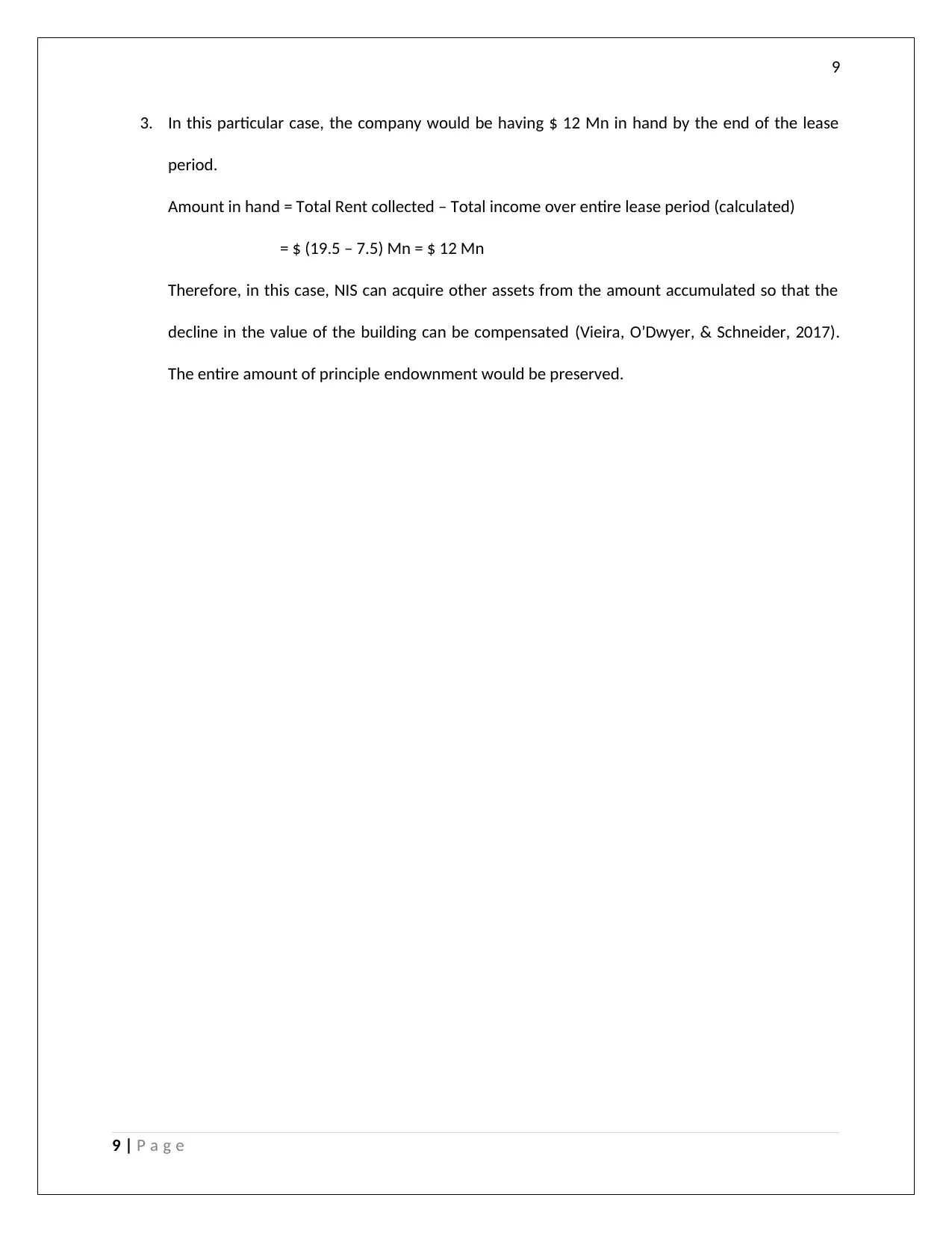
9
3. In this particular case, the company would be having $ 12 Mn in hand by the end of the lease
period.
Amount in hand = Total Rent collected – Total income over entire lease period (calculated)
= $ (19.5 – 7.5) Mn = $ 12 Mn
Therefore, in this case, NIS can acquire other assets from the amount accumulated so that the
decline in the value of the building can be compensated (Vieira, O’Dwyer, & Schneider, 2017).
The entire amount of principle endownment would be preserved.
9 | P a g e
3. In this particular case, the company would be having $ 12 Mn in hand by the end of the lease
period.
Amount in hand = Total Rent collected – Total income over entire lease period (calculated)
= $ (19.5 – 7.5) Mn = $ 12 Mn
Therefore, in this case, NIS can acquire other assets from the amount accumulated so that the
decline in the value of the building can be compensated (Vieira, O’Dwyer, & Schneider, 2017).
The entire amount of principle endownment would be preserved.
9 | P a g e
Paraphrase This Document
Need a fresh take? Get an instant paraphrase of this document with our AI Paraphraser
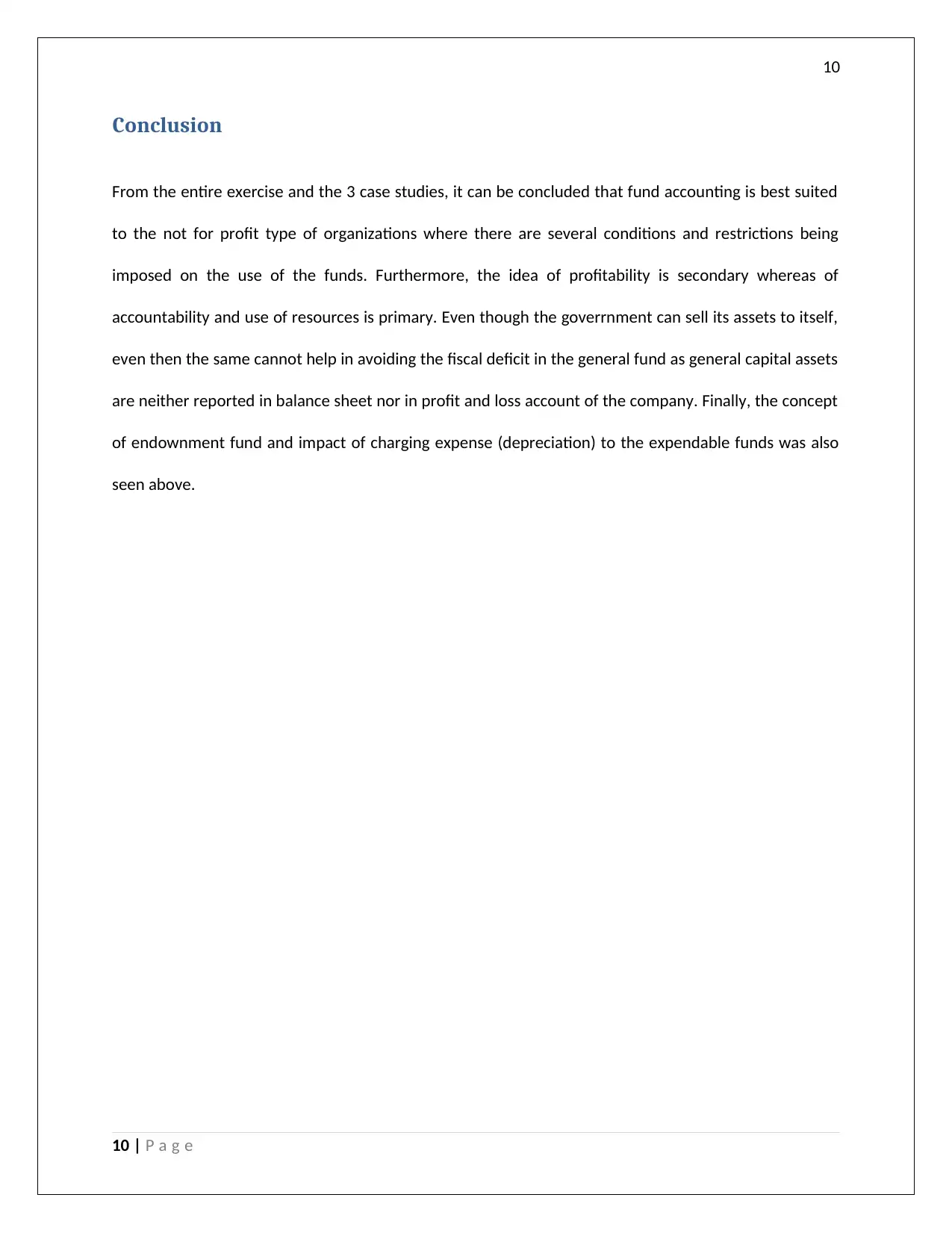
10
Conclusion
From the entire exercise and the 3 case studies, it can be concluded that fund accounting is best suited
to the not for profit type of organizations where there are several conditions and restrictions being
imposed on the use of the funds. Furthermore, the idea of profitability is secondary whereas of
accountability and use of resources is primary. Even though the goverrnment can sell its assets to itself,
even then the same cannot help in avoiding the fiscal deficit in the general fund as general capital assets
are neither reported in balance sheet nor in profit and loss account of the company. Finally, the concept
of endownment fund and impact of charging expense (depreciation) to the expendable funds was also
seen above.
10 | P a g e
Conclusion
From the entire exercise and the 3 case studies, it can be concluded that fund accounting is best suited
to the not for profit type of organizations where there are several conditions and restrictions being
imposed on the use of the funds. Furthermore, the idea of profitability is secondary whereas of
accountability and use of resources is primary. Even though the goverrnment can sell its assets to itself,
even then the same cannot help in avoiding the fiscal deficit in the general fund as general capital assets
are neither reported in balance sheet nor in profit and loss account of the company. Finally, the concept
of endownment fund and impact of charging expense (depreciation) to the expendable funds was also
seen above.
10 | P a g e
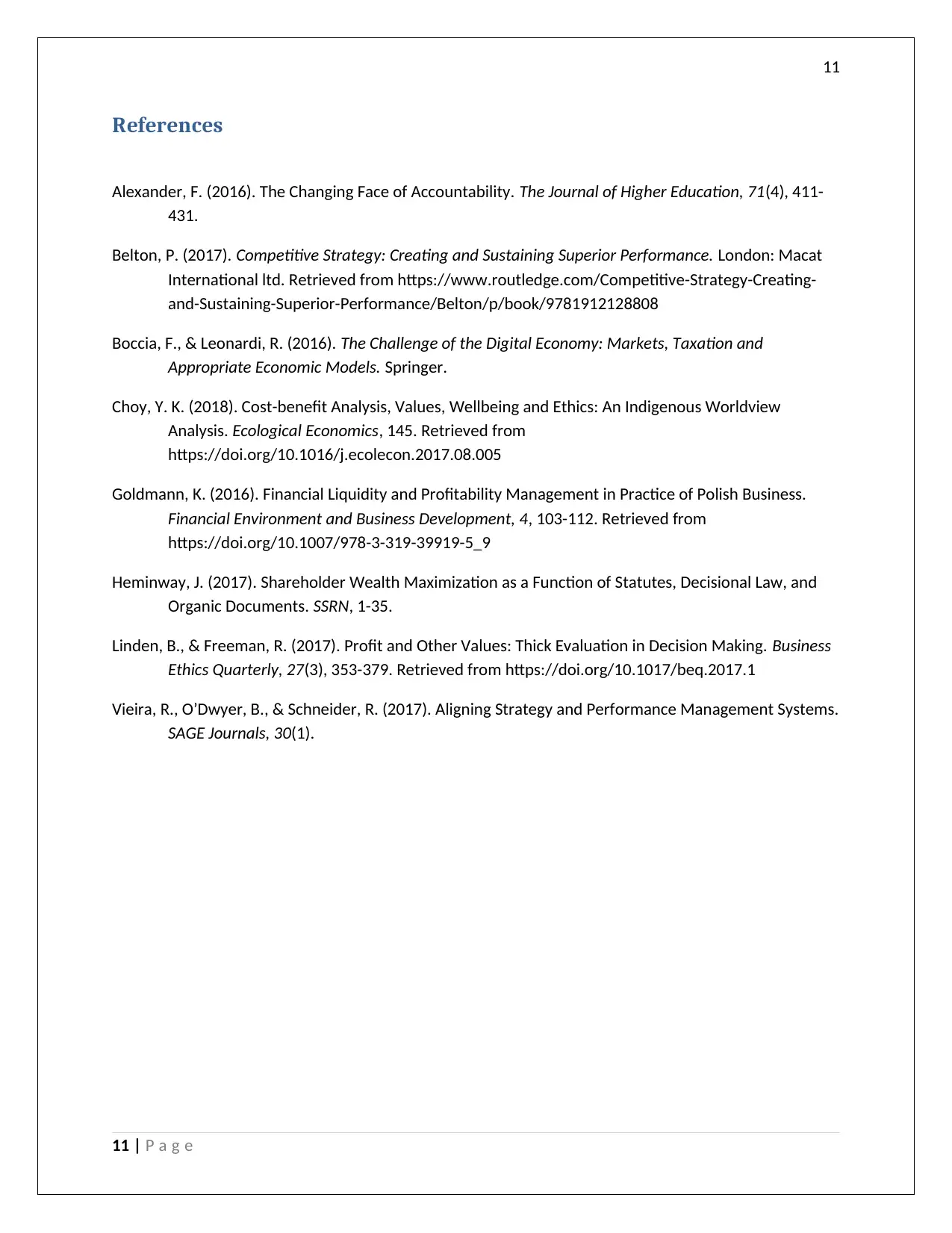
11
References
Alexander, F. (2016). The Changing Face of Accountability. The Journal of Higher Education, 71(4), 411-
431.
Belton, P. (2017). Competitive Strategy: Creating and Sustaining Superior Performance. London: Macat
International ltd. Retrieved from https://www.routledge.com/Competitive-Strategy-Creating-
and-Sustaining-Superior-Performance/Belton/p/book/9781912128808
Boccia, F., & Leonardi, R. (2016). The Challenge of the Digital Economy: Markets, Taxation and
Appropriate Economic Models. Springer.
Choy, Y. K. (2018). Cost-benefit Analysis, Values, Wellbeing and Ethics: An Indigenous Worldview
Analysis. Ecological Economics, 145. Retrieved from
https://doi.org/10.1016/j.ecolecon.2017.08.005
Goldmann, K. (2016). Financial Liquidity and Profitability Management in Practice of Polish Business.
Financial Environment and Business Development, 4, 103-112. Retrieved from
https://doi.org/10.1007/978-3-319-39919-5_9
Heminway, J. (2017). Shareholder Wealth Maximization as a Function of Statutes, Decisional Law, and
Organic Documents. SSRN, 1-35.
Linden, B., & Freeman, R. (2017). Profit and Other Values: Thick Evaluation in Decision Making. Business
Ethics Quarterly, 27(3), 353-379. Retrieved from https://doi.org/10.1017/beq.2017.1
Vieira, R., O’Dwyer, B., & Schneider, R. (2017). Aligning Strategy and Performance Management Systems.
SAGE Journals, 30(1).
11 | P a g e
References
Alexander, F. (2016). The Changing Face of Accountability. The Journal of Higher Education, 71(4), 411-
431.
Belton, P. (2017). Competitive Strategy: Creating and Sustaining Superior Performance. London: Macat
International ltd. Retrieved from https://www.routledge.com/Competitive-Strategy-Creating-
and-Sustaining-Superior-Performance/Belton/p/book/9781912128808
Boccia, F., & Leonardi, R. (2016). The Challenge of the Digital Economy: Markets, Taxation and
Appropriate Economic Models. Springer.
Choy, Y. K. (2018). Cost-benefit Analysis, Values, Wellbeing and Ethics: An Indigenous Worldview
Analysis. Ecological Economics, 145. Retrieved from
https://doi.org/10.1016/j.ecolecon.2017.08.005
Goldmann, K. (2016). Financial Liquidity and Profitability Management in Practice of Polish Business.
Financial Environment and Business Development, 4, 103-112. Retrieved from
https://doi.org/10.1007/978-3-319-39919-5_9
Heminway, J. (2017). Shareholder Wealth Maximization as a Function of Statutes, Decisional Law, and
Organic Documents. SSRN, 1-35.
Linden, B., & Freeman, R. (2017). Profit and Other Values: Thick Evaluation in Decision Making. Business
Ethics Quarterly, 27(3), 353-379. Retrieved from https://doi.org/10.1017/beq.2017.1
Vieira, R., O’Dwyer, B., & Schneider, R. (2017). Aligning Strategy and Performance Management Systems.
SAGE Journals, 30(1).
11 | P a g e
⊘ This is a preview!⊘
Do you want full access?
Subscribe today to unlock all pages.

Trusted by 1+ million students worldwide
1 out of 12
Related Documents
Your All-in-One AI-Powered Toolkit for Academic Success.
+13062052269
info@desklib.com
Available 24*7 on WhatsApp / Email
![[object Object]](/_next/static/media/star-bottom.7253800d.svg)
Unlock your academic potential
Copyright © 2020–2025 A2Z Services. All Rights Reserved. Developed and managed by ZUCOL.





